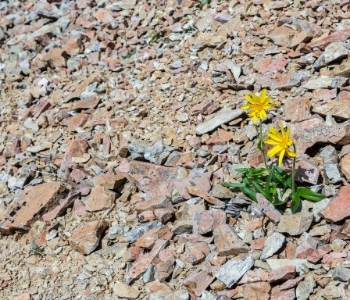
Pandemic. Recession. Unrest. Apparently, you can count on more than death and taxes in life! You can count on surges of change, too. Maybe you can’t be in full control of where you are as the wave of change hits you, but you can be in control of how you respond. It’s called resilience.
Resilience (noun)
1: the capability of a strained body to recover its size and shape after deformation caused especially by compressive stress
2: an ability to recover from or adjust easily to misfortune or change
-Merriam Webster
As people around the globe continue to wake up every day with COVID-19 still running wild, all of the strengths and weaknesses in humanity and the structures we have created are intermittently revealed. From the pervasive, rippling effects of systemic racism to the pivoting of productive and efficient companies and organizations, there is no hiding during periods of disruptive and wide-spread changes.
Where are you? Are you able to identify and act upon opportunities? Are you overwhelmed and paralyzed by the sudden waterfall of changes? Or are you somewhere in between?
In this series, I have touched upon some of the ways you and your organization could use this surge of change to more fully express the mission and values of your organization through the treatment of your employees. Seize the moment!
- The Hidden Costs of Working from Home | Part 1 of 5 June 19, 2020
- Your Career: The Hidden Costs of Working from Home | Part 2 of 5 July 14, 2020
- Your Physical Health: The Hidden Costs of Working from Home | Part 3 of 5 July 23, 2020
- Your Mental Health: The Hidden Costs of Working from Home | Part 4 of 5 August 24, 2020
Resiliency in Real Life – Your Life, Your Work
Resiliency is described and presented in so many different ways. That is why I’ve collected additional resources below that you can read on your own. But please don’t think resiliency has to be complicated and full of Venn diagrams. Instead, consider the resiliency of Elizabeth Warren!
“Nevertheless, she persisted,” said U.S. Senate Majority Leader Mitch McConnell about U.S. Senator Elizabeth Warren in 2017.
Sometimes you just have to persist in doing.
Building a culture of resiliency can start with one person. Even if your organization never develops a culture of resiliency, you can have one. And, while not usually as contagious as COVID-19, sometimes your role-modeling is all it takes to spread to others.
Persisting is an expression of one’s faith in change; that change is inevitable. It helps when you have faith, backed up by data, that things have indeed progressed positively for humanity. For that you might want to put the book, Factfulness, on your reading list.
Persisting is about showing up again and again. Believing that change is inevitable helps you step away from the emotion and make decisions and take actions that lead toward your desired outcomes.
I like to employ simple phrases or mantras I can repeat inside my head to remind me of my faith in change and to block out the negative chatter. One of my favorites? “Just breathe.” If you are religious, you are likely already familiar with a myriad of these kinds of phrases where you surrender your worry to a higher power, such as the Serenity Prayer.
While this kind of resiliency might be pretty easy to visualize as an individual, how does it play out at work?
Like many of you, I grew up eagerly anticipating Saturday morning cartoons on TV, like Wile E. Coyote & Road Runner. Wile E. Coyote was always trying to capture and eat the Road Runner, but he never quite got there. He was persistent for sure! But not successful. Why didn’t his persistence make him successful?
Resiliency is surviving adversity by adjusting to change – persistently.
Wile E. Coyote kept pursuing the Road Runner, but he never adjusted his strategies. He abandoned them after the first try failed. He never did the same thing twice. He had so many good ideas that could have worked with a little tweak, but were lost!
It is very likely that you have witnessed this lack of adjustment in the workplace at some point in your working career. You, however, do not have to replicate this unsuccessful behavior.
For example, you can persist in implementing a prospect management program by tweaking and adjusting your tactics until you find the combinations that work best in your environment. Then when everything changes (and it will), you know how to go back in to tinker with the program until it works again.
Resiliency as your Springboard
Take time out. Lay down on the ground and explore the vastness of the sky. Look over the water, or up at the mountains. Lay on your belly and focus on the grass-filled microcosm of earth that is usually under your feet. Find a way to put yourself in a place that shifts your perspective.
Then imagine the ways in which you might seize the real and exciting opportunities present in the midst of this crisis.
This could be your moment. This could be your organization’s moment. This pandemic could be the great opportunity to mirror your mission through the better treatment of your employees.
Additional Resources
- The Hidden Costs of Working from Home | Part 1 of 5 | Jennifer Filla | 2020
- Your Career: The Hidden Costs of Working from Home | Part 2 of 5 | Jennifer Filla | 2020
- Your Physical Health: The Hidden Costs of Working from Home | Part 3 of 5 | Jennifer Filla | 2020
- Your Mental Health: The Hidden Costs of Working from Home | Part 4 of 5 | Jennifer Filla | 2020
- Your Resiliency: The Hidden Costs of Working from Home | Part 5 of 5 | Jennifer Filla | 2020
Did you notice some of the dates on the resources below? Resiliency has been a thing long before the current crisis!
- Factfulness: Ten Reasons We’re Wrong About the World–and Why Things Are Better Than You Think | Rosling et al | 2018
- There Is Still Something We Can Do | Marianne Pelletier | 2020
- Building a Resilient Organizational Culture | Harvard Business Review | 2011
- How to Build a Resilient Company Culture That Will Help Every Employee Thrive | Inc. magazine | 2019
- Resilience is made up of five pillars | Bounce Back Project | undated
- Seven Skills of Resilience | Psychology Today | 2020
- Job Postings and Equity in the Profession | AFP, Mike Geiger | 2020

 Back in 2016 when Mark Noll posted “
Back in 2016 when Mark Noll posted “